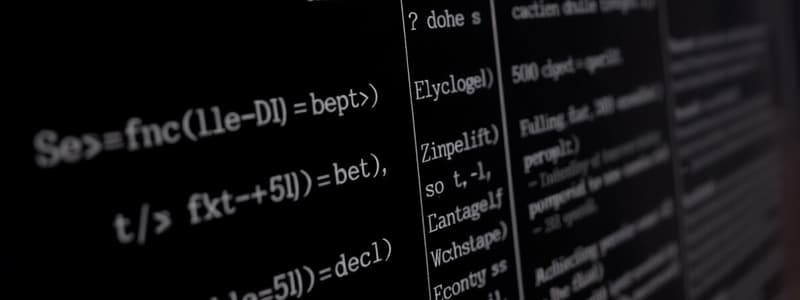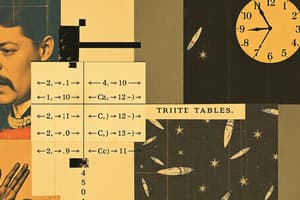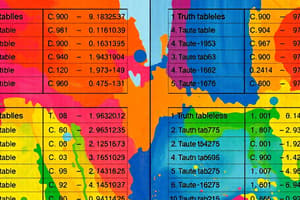Podcast
Questions and Answers
What does the notation ¬𝑝 represent in propositional logic?
What does the notation ¬𝑝 represent in propositional logic?
- Negation of 𝑝 (correct)
- Conjunction of 𝑝
- Implication of 𝑝
- Disjunction of 𝑝
If there are 4 atomic propositions, how many rows will be in the corresponding truth table?
If there are 4 atomic propositions, how many rows will be in the corresponding truth table?
- 2
- 16
- 4
- 8 (correct)
Which of the following expressions represents a conjunction?
Which of the following expressions represents a conjunction?
- 𝑊1,3 ∨ 𝑃3,1
- 𝑊1,3 ⇒ 𝑃3,1
- 𝑊1,3 ∧ 𝑃3,1 (correct)
- 𝑊1,3 ⇔ ¬𝑊2,2
Which of the following correctly describes an implication?
Which of the following correctly describes an implication?
What is the role of truth tables in propositional logic?
What is the role of truth tables in propositional logic?
What is one of the main abilities of knowledge-based agents?
What is one of the main abilities of knowledge-based agents?
Which of the following is NOT typically associated with logical agents?
Which of the following is NOT typically associated with logical agents?
What is a key characteristic of knowledge-based agents compared to problem-solving agents?
What is a key characteristic of knowledge-based agents compared to problem-solving agents?
In the context of propositional logic, what purpose do inference rules serve?
In the context of propositional logic, what purpose do inference rules serve?
Which statement accurately describes the Wumpus World?
Which statement accurately describes the Wumpus World?
What does conversion to CNF refer to in propositional logic?
What does conversion to CNF refer to in propositional logic?
What role does backward chaining play in propositional logic?
What role does backward chaining play in propositional logic?
Which aspect distinguishes knowledge-based agents from traditional agents?
Which aspect distinguishes knowledge-based agents from traditional agents?
What performance measure is awarded for collecting gold in Wumpus World?
What performance measure is awarded for collecting gold in Wumpus World?
What happens when the Wumpus is killed?
What happens when the Wumpus is killed?
What is one of the main characteristics of the Wumpus World environment?
What is one of the main characteristics of the Wumpus World environment?
What types of actions can the agent perform in Wumpus World?
What types of actions can the agent perform in Wumpus World?
How many elements are represented in the sensor list of the agent?
How many elements are represented in the sensor list of the agent?
What is the probability of any square (except the starting square) being a pit?
What is the probability of any square (except the starting square) being a pit?
Which action uses the only arrow in Wumpus World?
Which action uses the only arrow in Wumpus World?
What does the agent experience when it is in a square adjacent to a pit?
What does the agent experience when it is in a square adjacent to a pit?
In logical representation, what defines the truth or meaning of sentences?
In logical representation, what defines the truth or meaning of sentences?
What will happen if the agent takes an action that results in death?
What will happen if the agent takes an action that results in death?
What is the truth value of the expression $p
ightarrow q$ when $p$ is true and $q$ is false?
What is the truth value of the expression $p ightarrow q$ when $p$ is true and $q$ is false?
Which of the following operations yields a result of true only when one operand is true and the other is false?
Which of the following operations yields a result of true only when one operand is true and the other is false?
In the expression $p
ightarrow q$, what does it mean when both $p$ and $q$ are false?
In the expression $p ightarrow q$, what does it mean when both $p$ and $q$ are false?
What is the precedence order of the logical operators when evaluating expressions?
What is the precedence order of the logical operators when evaluating expressions?
What is the truth value of $p
eg q$ when $p$ is false?
What is the truth value of $p eg q$ when $p$ is false?
In the biconditional expression $p ext{ IFF } q$, under what circumstances is the expression true?
In the biconditional expression $p ext{ IFF } q$, under what circumstances is the expression true?
What will the result be of the expression $p
eg q ext{ OR } p ext{ AND } q$ when $p$ is false and $q$ is true?
What will the result be of the expression $p eg q ext{ OR } p ext{ AND } q$ when $p$ is false and $q$ is true?
Which of the following truth tables represents conjunction?
Which of the following truth tables represents conjunction?
Which term describes the formal structure of sentences in logic?
Which term describes the formal structure of sentences in logic?
What does soundness in propositional logic ensure?
What does soundness in propositional logic ensure?
How can the statement 'some squares are clean' be expressed in propositional logic?
How can the statement 'some squares are clean' be expressed in propositional logic?
What ability does Wumpus world require from logical agents?
What ability does Wumpus world require from logical agents?
Which type of logical inference is linear in time and complete for Horn clauses?
Which type of logical inference is linear in time and complete for Horn clauses?
What does completeness in propositional logic allow?
What does completeness in propositional logic allow?
Which concept refers to the truth of sentences relative to models in logic?
Which concept refers to the truth of sentences relative to models in logic?
Which of the following is not a basic concept of logic?
Which of the following is not a basic concept of logic?
What does a model in propositional logic assign to propositional symbols?
What does a model in propositional logic assign to propositional symbols?
Which rule states that if a battery is present in square B1, then either P1,2 or P2,1 must be true?
Which rule states that if a battery is present in square B1, then either P1,2 or P2,1 must be true?
When is KB ⊨ P1,2 considered true?
When is KB ⊨ P1,2 considered true?
Which rule asserts that the absence of the battery in square B1 leads to a condition being true?
Which rule asserts that the absence of the battery in square B1 leads to a condition being true?
How many propositional symbols are used in the reduced Wumpus world?
How many propositional symbols are used in the reduced Wumpus world?
What does the inference rule stating B1,1 ⇒ P1,2 ∨ P2,1 imply?
What does the inference rule stating B1,1 ⇒ P1,2 ∨ P2,1 imply?
Which of the following is true about the inference mechanism in propositional logic?
Which of the following is true about the inference mechanism in propositional logic?
What is the significance of the rule ¬P1,1 in the context of the Wumpus world?
What is the significance of the rule ¬P1,1 in the context of the Wumpus world?
Flashcards
Knowledge-based Agent
Knowledge-based Agent
An agent capable of representing knowledge about its environment, its goals, and the current situation using logical sentences, and then using inference to determine the appropriate action to achieve its goals.
The Wumpus World
The Wumpus World
A representation of a world where an agent can learn about its environment through perception and act to achieve its goals.
Logical Agent
Logical Agent
An agent that uses logic to reason about its environment and make decisions.
Propositions
Propositions
Signup and view all the flashcards
Inference Rules
Inference Rules
Signup and view all the flashcards
Model Checking
Model Checking
Signup and view all the flashcards
Theorem Proving
Theorem Proving
Signup and view all the flashcards
Proof by Resolution
Proof by Resolution
Signup and view all the flashcards
Compound Proposition
Compound Proposition
Signup and view all the flashcards
Negation (¬)
Negation (¬)
Signup and view all the flashcards
Conjunction (∧)
Conjunction (∧)
Signup and view all the flashcards
Disjunction (∨)
Disjunction (∨)
Signup and view all the flashcards
Implication (⇒)
Implication (⇒)
Signup and view all the flashcards
Wumpus World
Wumpus World
Signup and view all the flashcards
Performance Measure
Performance Measure
Signup and view all the flashcards
Wumpus World Sensations
Wumpus World Sensations
Signup and view all the flashcards
Wumpus World Actions
Wumpus World Actions
Signup and view all the flashcards
Wumpus World Sensor Information
Wumpus World Sensor Information
Signup and view all the flashcards
Partially Observable Environment
Partially Observable Environment
Signup and view all the flashcards
Static Environment
Static Environment
Signup and view all the flashcards
Sequential Environment
Sequential Environment
Signup and view all the flashcards
Knowledge Base
Knowledge Base
Signup and view all the flashcards
Logic in AI
Logic in AI
Signup and view all the flashcards
Exclusive Or (⨁)
Exclusive Or (⨁)
Signup and view all the flashcards
Biconditional (⟺)
Biconditional (⟺)
Signup and view all the flashcards
Operator Precedence
Operator Precedence
Signup and view all the flashcards
Parentheses
Parentheses
Signup and view all the flashcards
Knowledge Base (KB)
Knowledge Base (KB)
Signup and view all the flashcards
Model
Model
Signup and view all the flashcards
Inference
Inference
Signup and view all the flashcards
P1,1 (or any P,)
P1,1 (or any P
Signup and view all the flashcards
B1,1 (or any B,)
B1,1 (or any B
Signup and view all the flashcards
Logical Syntax
Logical Syntax
Signup and view all the flashcards
Logical Semantics
Logical Semantics
Signup and view all the flashcards
Logical Inference
Logical Inference
Signup and view all the flashcards
Sound Inference System
Sound Inference System
Signup and view all the flashcards
Complete Inference System
Complete Inference System
Signup and view all the flashcards
Propositional Logic
Propositional Logic
Signup and view all the flashcards
Study Notes
Propositional Logic
- Propositional logic (PL) is the simplest form of logic
- A proposition is a declarative statement that is either true or false
- Atomic propositions are single symbols (e.g., uppercase letters with or without subscripts)
- Compound propositions are built from atomic propositions using logical connectives (e.g., conjunction, disjunction) and parentheses
- Logical connectors include negation, conjunction, disjunction, implication and biconditional
- Truth tables are used to determine the truth values of propositions
Knowledge-based Agents
- Intelligent agents need knowledge about the world to make good decisions
- Knowledge bases are composed of sentences (assertions about the world) and inference mechanisms
- Knowledge bases contain domain-specific content
- Inference mechanisms use domain-independent algorithms to derive new information
- Declarative approach to building agent involves telling it what to know and asking what to do.
The Wumpus World
- A 4x4 grid environment with pits, wumpus, and gold
- An agent starts in a room and needs to navigate the cave avoiding the wumpus and pit
- Agent perceives the environment (stench, breeze, glitter)
Overview
- Knowledge-based agents, Wumpus World, logical agents, building propositions, inference rules, theorem proving
- Conversion to CNF
- Forward and Backward Chaining
Inference Rules
- Modus Ponens
- Modus Tollens
- Common rules
- Addition p pV q
- Simplification pΛ q q
- Disjunctive-syllogism pV q not p q
- Hypothetical-syllogism p → q q → r p → r
- Types of propositions: tautology, contradiction, contingency
Truth Tables
- Semantics defined by truth tables.
- Boolean values are true or false
- Number of rows in a truth table is 2n where n is the number of atomic propositions
- Used for propositional logic evaluation.
Logical Equivalence
- Two propositions are logically equivalent if their truth tables agree.
- Written as p ≡ q or simply p = q
Properties of Operators
- Commutativity; associativity, identity, double-negation elimination, idempotence
- Distributivity
- De Morgan's laws
Theorem Proving and Proof by Resolution
- Search for proofs is a more efficient way compared to truth table enumeration
- Resolution is a complete inference rule for propositional logic
Conversion to CNF and Resolution Algorithm
- Conversion (steps):
- Eliminate equivalencies
- Eliminate implications
- Move inwards using de Morgan's laws and double negation
- Apply distributivity law (over AND/OR) and flatten
- Resolution inference rule (CNF): rule used to derive new conclusions
Forward and Backward Chaining
- Forward Chaining: works from facts to conclusion
- Backward Chaining: works from goal to facts
Limits of Propositional Logic
- Propositional logic has limitations in expressing complex information about the world
- Not expressive enough to describe all scenarios.
- Not compact enough for certain types of information
Studying That Suits You
Use AI to generate personalized quizzes and flashcards to suit your learning preferences.




